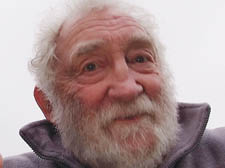|
|
 |
| |

David Bellamy will be the top speaker at a conference organised by Finsbury Park-based Natural Death Centre next weekend. |
Bury black, green is the colour for a funeral that’s eco-friendly
Charity offers tips on how to depart the world in a plain cardboard coffin
WORLD-famous conservationist David Bellamy will be top speaker at a conference organised by Finsbury Park-based Natural Death Centre next weekend.
Dr Bellamy will remind his audience he is planning to be buried in one of the Church of England’s woodland sites, “where I hope to grow into a tree, and where one day someone will chop me down and make me into a beautiful piece of furniture”.
The conference marks the extraordinary rise in popularity of green burials – regarded as eccentric just 10 years ago, but now almost mainstream.
In 2000, novelist Barbara Cartland was buried in a cardboard coffin in the grounds of her Hatfield home near a 400-year-old oak. Mourners took leaves from the tree as a memento.
Singer Adam Faith and Body Shop founder Anita Roddick have had green burials.
As cemeteries rapidly fill up and with cremation contributing to air pollution, green burials are seen as a way of returning our bodies to nature without harming the environment.
The aim is to bury the dead, without a headstone or any conventional marker, in a natural environment such as a meadow or woodland.
Most natural burial sites require the use of a biodegradable coffin which may be made from wickerwork, cane, bamboo or even compressed paper.
With bushes, trees and shrubs planted near the graves, eventually the site will return to its natural beauty.
According to Mike Jarvis, director of the Natural Death Centre, in Blackstock Mews, green burials and ceremonies are cheaper than the conventional alternative and can be a lot less formal.
“Normal funeral services in a church can be quite scary and forbidding,” he said. “Everyone wears black. But people can choose less formal arrangements.
“A plain, cardboard coffin can be painted and decorated. Little children can put their handprints or footprints down. They can write jokes or serious messages.
“People will often paint and decorate their own coffin in advance. It can help dispel the fear of death and be very empowering.”
The centre, a small independent charity, has been giving practical advice on green and unconventional funerals for 16 years.
Mike and his colleague, Adeline O’Keeffe, are the only paid workers, but there is a team of volunteers.
He said: “The first natural burial ground opened in 1993 in Carlisle. Today there are 228 all over the UK, with seven in Greater London, including Epping Forest.
“Islington is difficult because there is very little green space but Islington Cemetery at East Finchley is planning to provide a small area for natural burials.
“They are sending a representative to the conference.”
Best of all, green burials can be a lot cheaper than the conventional option, ranging from £100 for a basic cardboard coffin to £700 for something more elaborate.
Mr Jarvis added: “People may be looking for a humanist funeral or a non-Christian spiritual ceremony.
“The burial grounds themselves can be owned by individuals, charitable trusts, wildlife trusts or local authorities.”
The London Green Funeral Exhibition and conference is on Saturday, April 19, in Conway Hall, Red Lion Square, Holborn, from 10.30am to 4pm.
For more details about green burials, contact Natural Death Centre, at 12A Blackstock Mews, on 020 7359 8391. |
 |
|
| |
| |
| |
| |
| |
|
 |
|